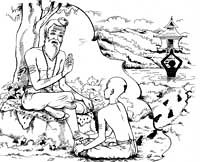We would be familiar with the verse:
Gururbrahmä gurur vishnur gururdevo maheshvaraha
Guru Sakshat param Brahma Tasmai Sri Gurave Namaha
This verse is an adaptation from a verse in the Guru Gita:
Gururbrahmä gururvishnur, gururdevo maheshvaraha
Gurureva parabrahma,tasmai srigurave namaha
The Guru Gita is an exalted text in the form of dialogue between Lord Shiva and Parvati Devi in the Skanda Purana. This text solely deals with the Glory of the Guru, the way of behaviour in the Presence of Guru, devotion to the Guru, the way of Moksha by adoring the form of the Guru and living by his / her teachings.
Lord Shiva has categorically stated that of all the stotras, the Guru Gita is the most powerful and efficacious. This text differs from other stotras in a sense that it contains an extensive Phalasruti, spread across the portions of this text, rather than at the end of the text. In this sense, it differs from the Vishnu sahasranama and other stotras, wherein most of the Phalasruti is placed after the 1000 names.
An online text is posted on the website of Sri Nannagaru.
Gururbrahmä gurur vishnur gururdevo maheshvaraha
Guru Sakshat param Brahma Tasmai Sri Gurave Namaha
This verse is an adaptation from a verse in the Guru Gita:
Gururbrahmä gururvishnur, gururdevo maheshvaraha
Gurureva parabrahma,tasmai srigurave namaha
The Guru Gita is an exalted text in the form of dialogue between Lord Shiva and Parvati Devi in the Skanda Purana. This text solely deals with the Glory of the Guru, the way of behaviour in the Presence of Guru, devotion to the Guru, the way of Moksha by adoring the form of the Guru and living by his / her teachings.
Lord Shiva has categorically stated that of all the stotras, the Guru Gita is the most powerful and efficacious. This text differs from other stotras in a sense that it contains an extensive Phalasruti, spread across the portions of this text, rather than at the end of the text. In this sense, it differs from the Vishnu sahasranama and other stotras, wherein most of the Phalasruti is placed after the 1000 names.
An online text is posted on the website of Sri Nannagaru.

No comments:
Post a Comment